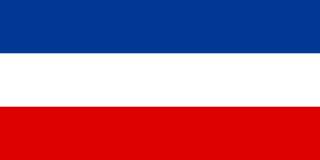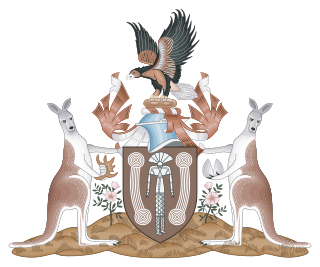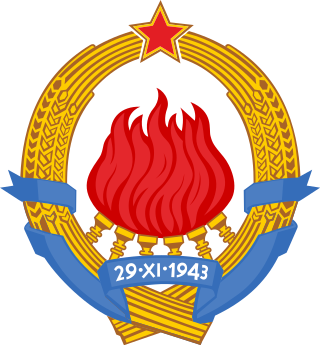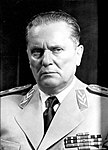
President is a common title for the head of state in most republics. The president of a nation is, generally speaking, the head of the government and the fundamental leader of the country or the ceremonial head of state.

Serbia and Montenegro was a country in Southeast Europe located in the Balkans that existed from 1992 to 2006, following the breakup of the Socialist Federal Republic of Yugoslavia which bordered Hungary to the north, Romania to the northeast, Bulgaria to the southeast, Macedonia to the south, Croatia and Bosnia and Herzegovina to the west, and Albania to the southwest. The state was founded on 27 April 1992 as the Federal Republic of Yugoslavia, known as FR Yugoslavia or simply Yugoslavia which comprised the Republic of Serbia and the Republic of Montenegro. In February 2003, FR Yugoslavia was transformed from a federal republic to a political union until Montenegro seceded from the union in June 2006, leading to the full independence of both Serbia and Montenegro.

The United Nations member states are the 193 sovereign states that are members of the United Nations (UN) and have equal representation in the UN General Assembly. The UN is the world's largest intergovernmental organization.

Yugoslavia was a country in Southeast Europe and Central Europe for most of the 20th century. It came into existence after World War I in 1918 under the name of the Kingdom of Serbs, Croats and Slovenes by the merger of the provisional State of Slovenes, Croats and Serbs with the Kingdom of Serbia, and constituted the first union of the South Slavic people as a sovereign state, following centuries in which the region had been part of the Ottoman Empire and Austria-Hungary. Peter I of Serbia was its first sovereign. The kingdom gained international recognition on 13 July 1922 at the Conference of Ambassadors in Paris. The official name of the state was changed to Kingdom of Yugoslavia on 3 October 1929.

The Socialist Federal Republic of Yugoslavia, commonly referred to as SFR Yugoslavia or simply as Yugoslavia, was a country in Central and Southeast Europe. It emerged in 1945, following World War II, and lasted until 1992, with the breakup of Yugoslavia occurring as a consequence of the Yugoslav Wars. Spanning an area of 255,804 square kilometres (98,766 sq mi) in the Balkans, Yugoslavia was bordered by the Adriatic Sea and Italy to the west, by Austria and Hungary to the north, by Bulgaria and Romania to the east, and by Albania and Greece to the south. It was a one-party socialist state and federation governed by the League of Communists of Yugoslavia, and had six constituent republics: Bosnia and Herzegovina, Croatia, Macedonia, Montenegro, Serbia, and Slovenia. Within Serbia was the Yugoslav capital city of Belgrade as well as two autonomous Yugoslav provinces: Kosovo and Vojvodina.

The Parliament of Serbia and Montenegro was the legislative body of Serbia and Montenegro. The parliament was unicameral and was made up of 126 deputies, of which 91 were from Serbia and 35 were from Montenegro. The parliament was established in 1992 as the Federal Assembly of Yugoslavia as a direct replacement for Parliament of Yugoslavia and was renamed in 2003. With the declaration of independence of Montenegro on June 3, 2006, the parliament ceased to exist.

The breakup of Yugoslavia occurred as a result of a series of political upheavals and conflicts during the early 1990s. After a period of political and economic crisis in the 1980s, constituent republics of the Socialist Federal Republic of Yugoslavia split apart, but the unresolved issues caused bitter inter-ethnic Yugoslav wars. The wars primarily affected Bosnia and Herzegovina, neighbouring parts of Croatia and, some years later, Kosovo.

The overthrow of Slobodan Milošević in Belgrade, Yugoslavia, began after the presidential election on 24 September and culminated in the downfall of Slobodan Milošević's government on 5 October 2000. It is sometimes referred to as the 5 October Overthrow and sometimes colloquially called the Bager revolucija, after one of the most memorable episodes from the day-long protest in which a heavy equipment operator charged the Radio Television of Serbia building, considered to be symbolic of the Milošević regime's propaganda.

United Nations Security Council resolution 1244, adopted on 10 June 1999, after recalling resolutions 1160 (1998), 1199 (1998), 1203 (1998) and 1239 (1999), authorised an international civil and military presence in the Federal Republic of Yugoslavia and established the United Nations Interim Administration Mission in Kosovo (UNMIK). It followed an agreement by Yugoslav President Slobodan Milošević to terms proposed by President of Finland Martti Ahtisaari and former Prime Minister of Russia Viktor Chernomyrdin on 8 June, involving withdrawal of all Yugoslav state forces from Kosovo.

The Northern Territory Legislative Council was the partly elected governing body of the Northern Territory of Australia from 1947 until its replacement by the fully elected Northern Territory Legislative Assembly in 1974.

General elections were held in Yugoslavia on 24 September 2000. They included the presidential election, which was held using the two-round system, with a second round scheduled for 8 October. After the first round, the Federal Electoral Commission announced that Vojislav Koštunica of the Democratic Opposition of Serbia (DOS) was just short of the majority of all votes cast needed to avoid a runoff against the runner-up and incumbent president Slobodan Milošević. However, the DOS coalition claimed that Koštunica had received 52.54% of the vote. This led to open conflict between the opposition and government. The opposition organized demonstrations in Belgrade on 5 October 2000, after which Milošević resigned on 7 October and conceded the presidency to Koštunica. USAID subsequently released revised election results with Koštunica having slightly over 50% of all votes cast.

The Parliament of Yugoslavia was the legislature of Yugoslavia. Before World War II in the Kingdom of Yugoslavia it was known as the National Assembly, while in the Socialist Federal Republic of Yugoslavia the name was changed to Federal Assembly. It functioned from 1920 to 1992 and resided in the building of the House of the National Assembly which subsequently served as the seat of the Parliament of Serbia and Montenegro and since 2006 hosts the National Assembly of Serbia.

Elections were held on municipal, provincial, republican and federal levels in Yugoslavia from its foundation in 1918 throughout its breakup in 1992.

The Federal Executive Council was the executive body of the Socialist Federal Republic of Yugoslavia (SFRY) responsible for state affairs and for supervising the implementation of laws. It consisted of up to 15 members elected by the Federal Assembly for a four-year term and the presidents of executive councils of republics and provinces. The Federal Executive Council played an important role in the Government of the SFRY from its creation in 1953 until the breakup of Yugoslavia in 1992.
Parliamentary elections were held in Yugoslavia on 11 November 1945. Due to an opposition boycott, the governing People's Front, dominated by the Communist Party of Yugoslavia, was the only organisation to participate in the elections. The Front officially claimed 90.48% of the vote, with turnout at 88.57%.
Parliamentary elections were held in Yugoslavia on 26 March 1950. They were the first held under undisguised Communist rule. The Communist Party of Yugoslavia had won the 1945 elections after an opposition boycott; soon afterward, the Communists abolished the monarchy and declared Yugoslavia a republic. The People's Front, dominated by the Communist Party, was the only organisation to contest the election, receiving 94.2% of the vote.
Parliamentary elections were held in Yugoslavia in 1969. The Socio-Political Council was elected on 13 April, the three Councils of Working Communities were elected on 23 April, and the Council of Nationalities was elected on 6, 7, 8 and 9 May.
The leader of the National Party of Australia is elected by majority vote of the federal parliamentary party. A deputy leader is elected in the same fashion. The party's longest-serving leader is Earle Page, who held the office from 1921 to 1939. It is historically rare for the incumbent leader and deputy leader to be opposed in a bid for re-election. In every instance when an incumbent leader retires he is always succeeded by his deputy. With the exception of the election of Ian Sinclair in 1984, every one of these deputy leaders ascended to the leadership unopposed.
Parliamentary elections were held in Yugoslavia between 22 and 24 November 1953. Candidates backed by the LCY-dominated Socialist Alliance of Working People of Yugoslavia won every seat.

The following events occurred in March 1958:












